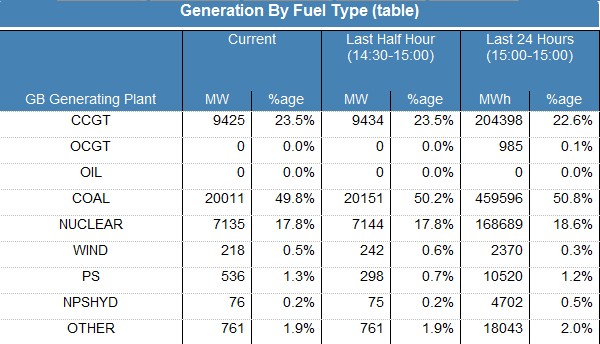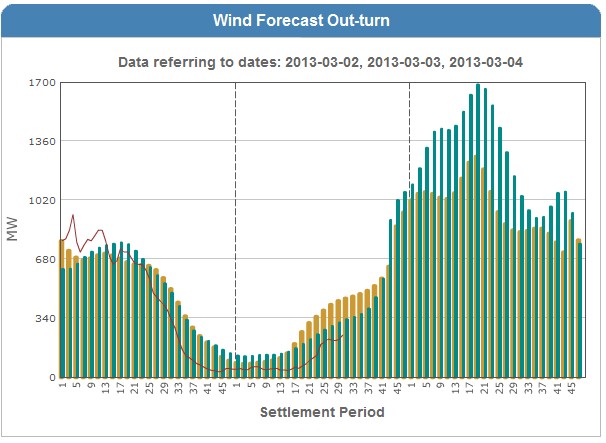The UK made the decision a while back to destroy their countryside and power the country with wind power. This noble gesture to destroy the environment in the name of green, is proving to be a complete disaster.
Over the last 24 hours, wind has produced only 0.3% of their average electricity needs. But even worse, their minimum generation dropped as low as 57 MW. That is only enough electricity to power about 50,000 homes. Are they planning on shutting the country down on calm days?




Why is the US and UK having so much trouble trying to switch to clean energy? Several US companies Obama funded have gone bust. Norway sucessfully uses hydro power for over 98% of its electricity: http://en.wikipedia.org/wiki/Electricity_sector_in_Norway.
Is hydro power easier then solar or wind? Or is Norway have the right geography for hydro power?
Ironically, Norway gets rich off of oil exports.
Greens block every dam in the US.
Why would they do this. Is it concern about animals/fish? It seems hydro power is what they should want, since it gives no CO2.
Because it upsets nature or something.
Norway has a popoulation of less than 4,707,270 people. The USA has a poulation of over 320 million people. There are many cities within the USA with more than 4,707,270 people. Hydro power apparently does not scale up continentally. I’m sure that there are more than 4,707,270 people in the USA serviced primarily by hydro like in the Pacific Northwest. Also as stated previoulsy the ‘Greens’ oppose hydro as well in the USA.
Is this a serious question, Petrov?
Norway is full of mountains and valleys, and very few people.
The UK is largely flat, and is mostly highly populated. Therefore there is very little room for dams. Furthermore we often have dry spells, when rivers get low.
Hydro supplies, I think, about 1% of total power. We could no doubt double that or quadruple that, at great cost. So then we’d get 2%? That means we could boil 2 kettles a day, instead of 1.
Norway has a lot of snowy mountains and not many people. A mere 5 million. Greater London alone has 8.3 million.
The only practical “Clean” (By which I guess you mean “carbon-free”, as gas is clean, producing but water and CO2 when burnt) energy is nuclear.
An argument I’ve made for years.
dropped as low as 57 MW. That is only enough electricity to power about 50,000 homes.
They would have to be bloody dim houses. 1.14Kw / house. Can’t boil a kettle with that.
57Mw will boil 19000 of my kettles. Over half of those peope will have to wait for me to drink my morning coffee. :))
http://www.gridwatch.templar.co.uk/
For a lot of the day yesterday the figures looked like this:
Coal 19.97GW
Nuclear 6.92GW
CCGT 8.33GW
Wind 0.04GW
Total Demand 37.40GW
At that moment wind was producing near one thousandth of the energy required in the UK.
Based on that output wind would have the ability to completely power the UK for a whole day once in every 3 years.
Fancy a cup tea love?
Based on the new improved .3 figure above, one could have a cup of tea once a year if you were wholly dependent on wind.
The good news is that unlike the wind, David Cameron’s pappy in law gets his big fat juicy public robbing subsidy, regardless of what the wind turbines are doing.
Right now it displays wind output at 0.46 GW, which is a bit of a jump from 0.04 GW.
I wonder what their average daily wind capacity is.
I think total wind capacity is about 15% of total electric demand. Average contribution from wind is 4%.
But of course that is not the point, Gina. What matters is the minimum they go down to , which is virtually zero. Therefore we need to pay to keep other generators, such as gas, to keep ticking over for when wind fails.(Unless of course you want to turn the lights out)
One example from Ireland. Go to the 2nd of March and it shows an average of 34.53MW of an installed energy of more than 1500MW. Just about 2% means that you have to have a lot of reserves to provide energy.
The output since the 22nd of February is quite low. The max value is a bit over 400MW and the average is about 160MW.
Forgot the link: http://www.eirgrid.com/operations/systemperformancedata/windgeneration/
“Are they planning on shutting the country down on calm days?”
Yes, yes they are.
As National Grid have repeatedly noted, average load factors quoted by the wind industry are meaningless, as are peak outputs, what matters is being able to deliver when required. This is what wind signally fails to do.
The other side of the coin is that wind is already delivering too much when we don’t need it. REF has some interesting official figures on ‘curtailment’ – large operators being asked to switch off when there is too much unstable output in the system.
REF show that the consumer paid £24 million in 2011 for wind producers not to produce. This is out of all proportion to payments to thermal generators who generally curtail output for free (they are saving fuel) or for about wholesale price. Meanwhile we see wind operators being paid 3-5 times wholesale price for curtailed output.